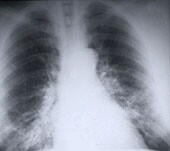
WEDNESDAY, Nov. 5, 2014 (HealthDay News) — Lung cancer screening with CT scans can be cost-effective while saving lives, a new study suggests.
But, there are two caveats to that finding — the procedure has to be performed by skilled professionals and the screening must be done on a very specific set of long-time smokers, the researchers noted.
Results from the National Lung Screening Trial (NLST) showed four years ago that annual CT scans can reduce lung cancer deaths by 20 percent in older, long-time smokers.
The new study, which uses data gathered during that national trial, concludes that screening for lung cancer would cost $81,000 for each year of quality life gained — lower than the generally accepted $100,000-per-year threshold for cost effectiveness.
“While it sounds like an awful lot, $100,000 to $150,000 per quality-adjusted life-year is considered a reasonable value within the United States,” said study author Dr. William Black, a professor of radiology at the Dartmouth University Institute for Health Policy and Clinical Practice. “It’s plausible to design a screening program for lung cancer that ultimately would be cost-effective.”
Black said the cost of screening always has been a concern among NLST researchers. “We decided early on there would be a cost-effectiveness study if it was proven there were a benefit,” he said.
A study earlier this year reported that lung cancer screening could cost Medicare $9.3 billion over five years, which amounts to a $3 per month premium increase for every Medicare patient.
Concerns have been raised over those costs, which prompted the U.S. Centers for Medicare and Medicaid Services to delay covering the procedure while it conducted a careful review. CMS is expected to announce its decision on lung cancer screening within the next few days, according to Black.
These new findings determined that screening can be cost-effective, but only if it is conducted on current or former smokers at particularly high risk, researchers report. The results are published in the Nov. 6 issue of the New England Journal of Medicine.
Specifically, screening should target current and former smokers aged 55 to 79 with at least a 30 pack-year history of smoking. Pack years are determined by multiplying the number of packs smoked daily by the number of years a person has smoked.
“It’s very important to target that population so when we start paying for screening, we reach the people who will benefit from it,” Black said, noting that only about a third of smokers in that age group have smoked enough to qualify for screening.
In addition, screening must be done by skilled radiologists who can accurately detect cancerous lesions, and followed up by talented doctors who are conservative in conducting additional scans or ordering biopsies, he said.
For example, since the initial NLST findings were published, researchers have determined it’s not necessary to follow up on detected nodules in the lungs that are between 4 millimeters (mm) and 6 mm in size, Black said.
“You could cause harm, and you could cause a lot of expense, so it’s important we set our criteria so we are detecting these small curable cancers but we aren’t over-treating them,” he said.
Dr. Otis Brawley, chief medical officer for the American Cancer Society, agreed that professional judgment and medical skill will be crucial in performing CT lung cancer screening cost effectively.
Brawley noted that in the trial, screening prevented 87 deaths for every 25,000 people screened, but also caused 16 deaths per 25,000 due to complications from biopsies. Six of those 16 deaths were in people who did not have cancer.
The screenings for the trial were conducted at medical centers that are highly skilled in imaging and cancer treatment, Brawley said. He is concerned that as lung cancer screening becomes more widespread, people will be over-diagnosed and harmed.
“For every 5.4 lives saved from lung cancer by screening, one life was lost due to screening,” he said. “If you go to hospitals that aren’t as good, you’re going to have an even higher proportion. You really need to have some quality assurances, to try to prevent these deaths from happening.”
More information
For more information on the National Lung Screening Trial, visit the U.S. National Institutes of Health.
Copyright © 2025 HealthDay. All rights reserved.

